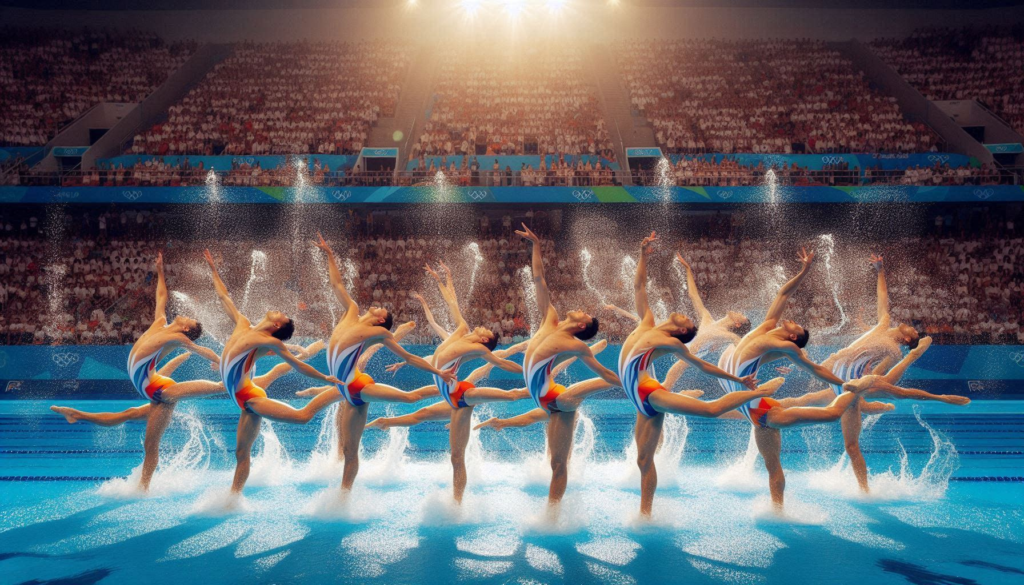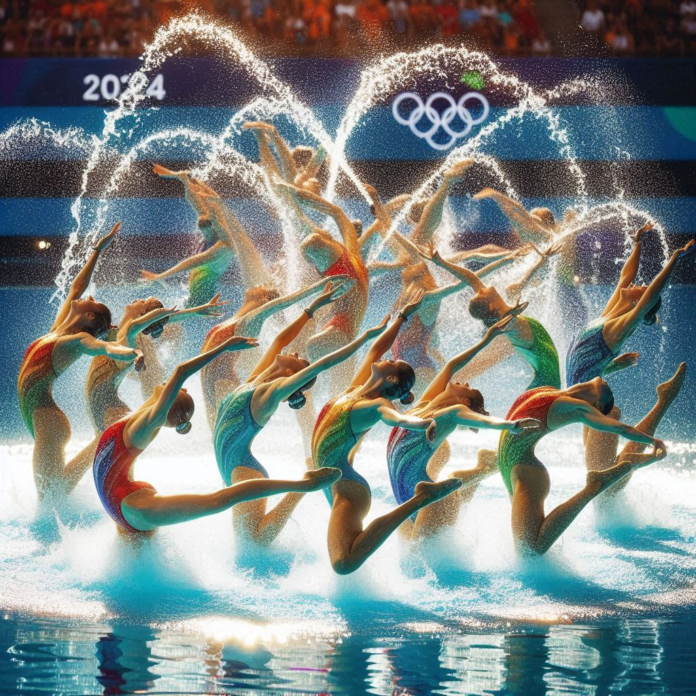Artistic Swimming at the 2024 Olympics: A report on study of a specialisation
Finally, artistic swimming which used to be known as synchronized swimming is an aquatic sport that combines the aspects of dance, gymnastics and swimming resulting in a creative display and performance. Since 1984, the sport has been included in the list of Olympic Games events and has been giving much thrill and excitement through the beauty of arts, hard maneuvering, and focus. Two thousand and twenty-four is going to be the year when artistic swimming will return to the adoration it deserves, and the world will watch the Summer Olympics in Paris, where the best representatives of the sport will fight for the coveted trophy.

ADAPTATION OF ARTISTIC SWIMMING AND THE WAY IT EVOLVED
Artistic swimming originated around the last decades of the 19 th-century and early 20 th-century as water ballet displays where fashionable in Europe and also in the United States of America. The bodies developed over the decades mainly the formal competitions began in the 1930s. Thereby, artistic swimming was only performed by women and assumed the status of the women-only Olympic sport when it was included into the Olympic program in Los Angeles in 1984.
International Swimming Federation commonly known as FINA changed the name of the sport from synchronized swimming to artistic swimming in 2017 with the intent of focusing more n the artistic side of the performance. This rebranding was also done with a view to contemporizing the sport and hence draw more people to it.
Oban, Artistic Swimming in the Olympics
The Olympic artistic swimming competition is divided into two events: The duet and the team competition Although these elements as well as other factors of the performance analysed earlier can be considered important, it is possible to assume that the final decision between two dances would be the most essential for both the group and the individuals that participated in the show. As a result the closest links between the performing arts are identified to be the duet and the team competition. Each event consists of two routines: One type is a technical routine and one is a free routine. The technical routine involves the performers doing a sequence of compulsory elements while the free routine entails more creativity and formation of figures.
In both events, the flavor includes the technical quality of the performance, artistic merit, and degree of difficulty. Ranking is based on the sum of the grades obtained in both technical and free routines.
The Duet Competition
In the duet competition, the performers dance together and try to execute the choreographical moves in unison. The technical- routine in the duet synchronized competition involves aspects such as lifts spins and patterns that have to be performed in compliance to laid down policies. Free routine provides the athletes with an opportunity to be creative, artistic and choreograph their movements usually in portraying a story or an emotion.
The Team Competition
The group event consists of eight people who swim together synchronously and design figures and positions in the water. Required elements are also prescribed for the technical routine of teams, however, the scale and complexity are higher in this case because the number of athletes to be worked with is larger. Free routine is normally an unstructured event that provides the chance to the teams to show their talents usually, presenting remarkable stunts or dances with the themes, costumes or music of their choice.
Preparation and Training
As a highly technical and artistic water sport, artistic swimming demand from the performers strength, flexibility, as well as endurance. Swimmers often rise to the elite level after many years of practice, which often includes, swimming numerous hours, strength training, and choreographing mat and pool performances.
Focusing on the specifics of artistic swimming training, it is crucial to mention that unlike divers, athletes perform extended movements in the water, that is why breath control also becomes the part of training. This means that one must undergo through a thorough training session in order to able to expand the lungs and wait longer while performing various stunts.
Aside from physical training of artistic swimmers they are trained along with the choreographers and coaches for having the best of both the worlds to have the techniques and stunning artistic performance in finales. This concerns choosing song(s), determining outfits, and fine-tuning each and every detail of the dance to make it sinuous and engaging.
Judging and Scoring
Artistic swimming is judged by a panel of judges who evaluate the performances based on three main criteria: We propose that execution, artistic impression, and difficulty are the key aspects that can be used to describe the level of art found in respectively ranked types of artworks.
Execution : Judges pay attention to things such as ease, fluidity, precision of the movements, coordination with the partner or the rest of the team, and strictly technical aspects of performance.
Artistic Impression: This category evaluates on aspects of creativity and presentation of the routine in relation to choreography and its interpretations of the music and aesthetics. Another factor that helps and impresses the judges is the ability of the athletes to convey emotions and tell a story.
Difficulty: Difficulty score correspond to the number and the degree of the routine’s elements’ difficulty. Which is why routines with more difficulty are ones that consist of complex stunts, formation and overall, more complex work done at the event.
Every routine is marked on a total of 100 points, which is distributed on the basis of the scores given to each of the three criteria. The total score for the technical routine and the total score for the free routine are computed to get the grand total and hence the final standing.
Socio-Political Development and New Features in the Year 2024
Looking at the events that may be a part of the Paris 2024 Olympics, there are bound to be some transitions and features that innovate artistic swimming. These could be changes in the activities and rules of judging, new rules on choreography and music choice, and the likelihood of shifts of focus to artistic aspects.
Among these, one of the most conceivable transformations can be the admission of combined-sexed teams where males can perform together with females. This would indeed be historic for the game to achieve such a status and progress though the issue of gender equality in the game is something that ought to have been addressed long time ago.
This spectacular discipline experienced the increase in the number of efforts to extol the values of athletic performance and intricacy in the recent decades. It is expected that the upcoming 2024 Olympics these elements of gymnastics will be presented in more demonstrative manner with the routines incorporating more complex lifts, higher spins, and more vigorous dance moves.
Major rivals and semis to focus on
Artistic swimming’s level in the 2024 Olympics will be presented by the list of the most outstanding sportsmen and sp sterners of this type of water terrain. It was long dictated by the teams of Russia, China, Japan, and Spain which have acted as pioneers of artistic swimming for a long time. These nations have continuely provided athletes of a very high caliber who have performed well in the duet as well as in the team categories.
Russia: In Olympic games, artistic swimming has always been an area that Russia dominates as proved by a series of gold medals they won. The elements of the performances of the Russian team are characterized by technical rigor, original choreographic solutions and a profound artistic charge. Still, unrest in this country or other current issues might affect their engagement or results in the 2024 Olympics.
China: Other countries have step by stepped into the forefront in recent years including China that has proven to be a tough competitor in the team event. Apparently, the Chinese team’s routines are synchronous, elegant and predicable, and the group achieves complex formations with relative accuracy.
Japan: Japan is also another country to watch, especially during the duets’ performance. The Japanese athletes can be characterized by the artistic element and creativity having elements of the Japanese culture interpolated in their performances.
Spain: Artistic swimming has always had its tradition in Spain, the athletes are characterized by their enthusiasm and emotional music. Another team that has always been favourites has been the Spanish team and they are deemed to offer stiff competition in the Paris event.
Apart from these seven countries, some other such as United States, Canada, and Italy are also considered strong teams, and they can give fight to these giant teams.
The Venue and Setting
Parade numismatics- The artistic swimming events, at the 2024 Olympics will be hosted at Paris La Défense Arena, a very modern and flexible facilities in the city. This motivated me to conduct a research through a case study on the prospecting modern tennis facility to host the competition with an adequate number of spectators.
The Venue and Setting
There are some peculiarities in organization of artistic swimming at the next Olympics in Paris; the competitions will take place in one of the most actual and multi-functional complexes of the capital of France – the Paris La Défense Arena. This new contemporary structure shall be suitable for competition, with accredited facilities evident and having the capability to contain many people.
Seating arrangement: The architecture of the arena will make it possible for the audience to have an aerial view of the performances and still see the companies’ of aesthetics in their interpretations of the performances to the last detail. For instance, the advanced lighting and sound equipment to be installed in the location will also be a plus as they will offer that feeling and look of an event that is very dramatic.
Artistic swimming ‘s association with the Paris Olympics
Artistic swimming is considered to have a number of breakthroughs with the start of the next Olympiad in Paris, 2024. Thus, embracing up-and-coming tendencies, innovations, and young athletes, the Paris Games will become proactive in signifying future changes in the sport. The Olympics also had a potential of introducing the new fans and new participants to the sport opening up a new market for the same.
The possibility of having mixed-gender teams could also go a long way in changing artistic swimming and allow for gender equality in sporting activities following the world’s current fashion.
In addition, the focus on artistic performance and uniqueness of the 2024 Olympics could create a fresh crop of artists and Directors of Chorography with the possibilities of artistic swimming. This could give birth to new techniques, style, and given approaches that would chart the way forward in the sport.
Conclusion
The artistic swimming in the 2024 Olympics will be highly entertaining along with exciting performances expected from the best performing artists of this world. It remains one of the most popular and innovative sports that combines elements of athleticism, artistry and advanced technologies that entertain the spectators and challenge the water adroitly.
It has attention of the entire world focused on who will be the new champions in the sport of artistic swimming as athletes warm up for the competition in Paris. Whether one would watch the synchronized swimmers of the Russian team with an elegance that is impeccable and skillful, the complex form of the Japanese duet or the passion Spaniards show in their performance, the Olympics to be held in 2024 are not going to disappoint the viewers with the least in terms of beauty and vigor of competition.
In the future years, the impact of the 2024 Olympic Games will probably be reflected in the development and further progress of the artistic swimming promoting the further yearning of numerous spirited artists to extend the boundaries of this genuinely amazing sporting events.



